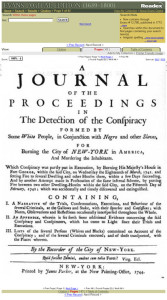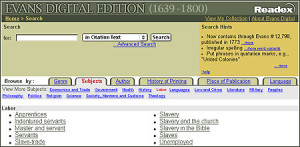Review of Evans Digital Edition, 1639-1800, produced and distributed by Readex/NewsBank, Inc., in cooperation with the American Antiquarian Society. Chester, Vt., 2003. Introduction | Cathy N. Davidson | Jay Fliegelman In the history of technology, it is customary to greet the new by waxing nostalgic for the old. In the 1940s, critics worried that sensory overload from the new medium of television would stifle the imagination stirred by the mysterious voices and sounds emanating from the radio. In the 1920s, social arbiters were sure that the radio would spell the demise of reading. So goes the generational parade, with excitement for the new coupled with mourning for what has been superseded. The reception history of technology is almost always part paean, part eulogy.
Nonetheless, I hold no nostalgia for the microform technology that preceded the Evans Digital. During the ten years in which I researched Revolution and the Word: The Rise of the Novel in America, a decrepit green microform reader hulked in the corner of my office like some giant ogre reminding me daily of more blurry pages to be read, more mind-numbing hours of searching ahead. I’m sure there are scholars of my generation and before who tingle when they recall the smell of wet copies oozing forth from a micoform printer (a friend once called it a “whiff of the void”), but I do not.
To be sure, in 1955 when the American Antiquarian Society launched its project to micropublish Charles Evans’s American Bibliography, it performed an inestimable service to scholarship, making virtually every book, pamphlet, and broadside published in America from 1639 to1800 accessible to those of us who lived away from major libraries. Without it, we would not have learned all we did. However, the technology itself was downright user-hostile. If the Evans Digital has rendered its microfiche parent obsolete, there’ll be no eulogies from me.
The Evans Digital will soon make 36,000 works and 2,400,000 images available and searchable to anyone who is a member of a library that owns the database-driven Website. Over fifty libraries had purchased the Evans Digital by the end of 2002. I can attest that the pages are as clean and clear as their microfiche parent and paper grandparent allow, with impressive high-resolution zoom capabilities that far exceed any microfiche magnifier. One can also download text or make copies that float out of one’s printer in an odorless dry form, ready for marking up or filing. Best of all, I was able to visit the Evans Digital site in my pajamas at 5:00 a.m. on a national holiday. This may be as close to scholarly nirvana as one can come.
More than convenience is at issue here. The Evans Digital inspires ideas. Without even trying, I find myself getting deliciously lost in the Evans Digital site in the same way that one can become lost in the stacks of a library. Time flies before I realize I’m reading from the 1744 journal of Daniel Horsmanden of the “proceedings in the detection of the conspiracy formed by some white people, in conjunction with Negro and other slaves, for burning the city of New-York in America, and murdering the inhabitants.”
This title was found through serendipity, as I was trying out different browse and search functions on the Evans Digital. A user can browse by genre, subjects, author, history of printing, and place of publication. Within each category, there are many additional secondary and then tertiary headings. Under Labor in the subject browser, there are five categories relating to slaves and slavery, and I immediately began clicking and searching, turning up scores of interesting titles.
As much as I love using the Evans Digital, three notes of caution should be sounded. The first is conceptual. Browser categories are a wonderful tool for grouping areas of knowledge and for inspiring intellectual associations, but they also can miss whole areas and, in this way, help determine what areas do or do not receive attention. I am particularly surprised and disappointed, for example, that women and gender are underrepresented as browsing categories in the Evans Digital, especially considering the importance of feminist scholarship of early American culture and society produced over the last decades.
A second caution has to do with completeness. No search of machine readable text will turn up every instance of the word for which one is searching. The Evans Digital has a wild card function to help locate words with variant or irregular spellings and to compensate for the long S of early American printing, but instructions for how to use this should be made more prominent. Even with wildcards, some words will be missed. It’s the best tool we have but students need to be warned (with the Evans Digital as with everything in the Information Age) that abundance is not completeness.
The third caution concerns the price of the Evans Digital. Surprised that my own library (which is aggressively sophisticated technologically), had not yet purchased the Evans Digital, I contacted them to find out why. The high price tag relative to other databases, plus a few kinks still to be worked out of the search engine, decided to make them wait a while before buying. The librarian with whom I discussed this noted a one-time payment of more than $50,000 plus a $2,000 annual access fee. When I put the same question to the folks at the Evans Digital, they noted a sliding-scale fee based on size of the institution and whether one had already purchased the microfiche Evans (which could be awarded “trade in” dollars). The price I was quoted ranged from $28,000 for small historical societies to $107,005. Unfortunately, that price tag could put a wonderful tool outside the reach of many institutions.
On the other hand, the microfiche Evans was also expensive in its day and lasted since 1955. Will the current Evans Digital have as long a shelf life, given the rapidity with which technologies change? No one can say. However, because it uses something techies call “dirty ASCII,” its machine-readable copy promises to be adaptable even as new and improved software emerges, without the necessity of redigitizing. The producers of the Evans Digital also welcome feedback about any glitches or ideas about areas of improvement so that they can make it as useful a tool as possible. For example, apparently I am not alone in regretting that the convenient “My Collection” bookmarking log disappears once one exits the Evans site. Perhaps Evans Digital will find a way to allow one to keep these bookmarked documents as one does an account on eBay or Amazon.com.
The Evans Digital by no means renders the physical archive of the library obsolete, but adds a wonderful new tool to our scholarly toolbox. As I printed out page after page of texts found on the Evans Digital, I again wondered whatever happened to that promise of a paperless society. Electronic publishing is a cumbersome and inefficient way of reading an entire book (rather than doing research in texts). The area of history of the book scholarship focusing on the materiality of books is also beyond what any database can provide. One of the great moments in my academic life was sitting in the American Antiquarian Society gazing in wonder at everyedition of Charlotte Temple owned by the library. Dozens of them, in different sizes, spanning well over a hundred years in the life of this bestseller provided a visceral, visual history of printing in America. Opening these books, one learned specific features about ink, paper, and binding, and even found evidence (from inscriptions and marginalia) of actual readers.
Those who criticize technological change do so out of a conviction that technology changes how we think. They are correct in that assumption, which is one reason I’m thrilled by the Evans Digital. “Pipes” and “content” (media and message) are not easily separable. The Evans Digital encourages us to make connections that would have been exceedingly difficult (if not impossible) before. It will facilitate new areas of research that could not have been accomplished in a lifetime spent only in the library or bent over a microform reader.
This article originally appeared in issue 3.3 (April, 2003).
Cathy N. Davidson is Ruth F. DeVarney Professor of English, director of the John Hope Franklin Humanities Institute, and vice provost for interdisciplinary studies at Duke University. An expanded edition of her Revolution and the Word: The Rise of the Novel in America (New York, 1986) will be published by Oxford University Press in 2004.





















